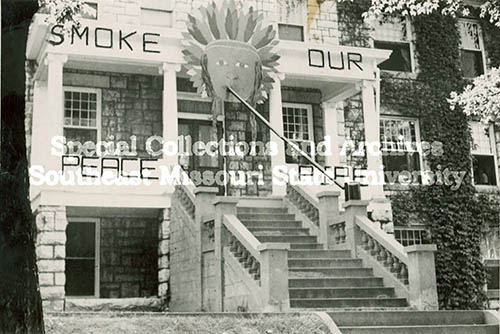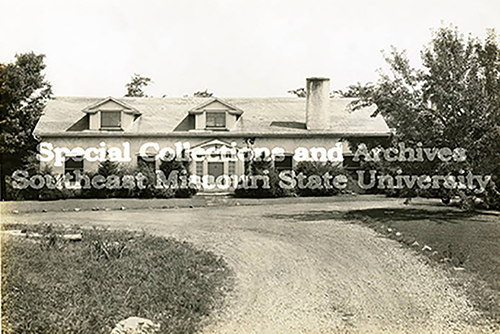1920-1929
Continue to main content1920
March 1920
Students are required to attend chapel services three days a week
"Southeast holds its first Homecoming."
1920

1920s
The college mascot is the Indian, or Otahkian for the women's squads.
1921
June 8
Students string up and burn effigies of members of the Board of Regents in front of Academic Hall in opposition to the Board’s dismissal of President Dearmont, thus inaugurating “Dearmont Day.” It is believed that Dearmont’s opposition to Gov. Arthur Hyde’s plan to place all five state teacher colleges under the authority of a single governing body, and his support for the League of Nations, cost him his job.
President Joseph Serena becomes Southeast’s eighth president. His administration was characterized by increased enrollment, accreditation by national education agencies, construction of an education building (Training School), refurbishing a college-owned house for the president; Houck Field and Houck Field House construction, internal reorganization as a college, development of a rural education program and decreased state appropriations. He also abolished dancing on campus, and students were required to attend chapel three times a week and assembly once a week.
Women had special regulations to follow. If a female and male student wished to go out together for dinner, they were required to be accompanied by a chaperone. Regulations also stated that if a woman were to go to the movies or ride in an automobile after 5 p.m., she must be in a group of at least four or have a chaperone. The dean of women also declared smoking undesirable for women at the Teachers College.
1922
February
The college farm is purchased.
May
An additional 124 acres of farmland is purchased to be used by the Department of Agriculture. The land was originally part of a grant from the Spanish government in the late 18th century to Don Louis Lorimier, founder of the city of Cape Girardeau. A wine cellar was the only building on the land. Louis Houck, a long-time member of the Board of Regents, led the conversion of the wine cellar into a home for the college’s president, Joseph Serena, and his wife.
1923
March 29
Southeast Missouri State Teachers College Radio Station WSAB goes on the air. It was the first broadcasting station in Cape Girardeau and southeast Missouri.
The Board of Regents gives faculty the authority to suspend or expel students based on disobedience, insubordination, dishonesty, drunkenness or immorality.
May 1923
An education building featuring 450 tons of native stone from a quarry owned by Louis Houck is dedicated. Today, the building is known as the “Rosemary Berkel Crisp Hall of Nursing”.
October 25
Southeast Missouri State Teachers College celebrates its Golden Jubilee with an event in Academic Hall, including the unveiling of a memorial plaque commemorating those who served from southeast Missouri in World War 1. Following the ceremony, a barbecue, parade and football game are held.
"Renovation of Wildwood is completed, and the Serena family moves in. The wife of President W.W. Parker is credited with naming “Wildwood”."
1923

1924
Some men, including the Men’s Glee Club, took to serenading the women’s dormitories, Albert and Leming halls.
President Serena announced a contest for original words for a school song. This song would be used to build school spirit and first place would get $5, second would get $3, and third would receive $2.
1925
A rock quarry that later would become the site of Houck Field is purchased for $11,000 at the recommendation of then-college President Joseph A. Serena.
A chapter of Kappa Delta Phi, a national teachers’ honorary fraternity, was established at the college.
November
A new circulation plan for The Capaha Arrow newspaper begins shifting distribution from all who wanted one on Tuesdays to only those attending chapel on Wednesdays.
1926
Civil War and World War I cannons are positioned along with a newly installed flagpole on Academic terraces. They were donated to World War II efforts in 1942.
The Board of Regents votes to name an athletic field and gym for Louis Houck. The land on which it stands was formerly Matteson Terrace, which previously served as a quarry.
The marching band begins playing during halftime of home football games.
1927
March 1927
The original Houck Field House is completed, which was the original home of Southeast’s basketball teams. A building constructed to host a Billy Sunday revival was given to the college after the completion of the revival. Materials from the structure were used to build the Field House. Today, Houck Field House is used for women’s volleyball and gymnastics. The building also houses locker rooms for baseball, soccer, softball and volleyball.
Southeast Missouri suffers one of its worst floods, and Houck Field House is used to house homeless people from Illinois.
1928
Pre-enrollment began for the first time.
1929
The Depression begins, the stock market crashes, and many Americans lose everything. Faculty salaries are cut by 15-20%, and enrollment drops because fewer families could afford to send their children to college.
Summer commencement is abolished to save money.
World Events
1920s
Prohibition begins in the United States.
1921
Warren Harding inaugurated as president of the United States.
1922
The BBC is established.
1923
Time Magazine published for first time.
Walt Disney Company founded.
1924
The first Winter Olympics are held in France.
1927
Charles Lindbergh makes the first nonstop flight from New York City to Paris.
Construction of Mt. Rushmore begins.
Southeast Missouri suffers one of its worst floods.
1928
Penicillin is discovered.
Bubble gum is invented.
The Mississippi River Bridge at Cape Girardeau is dedicated.
1929
Herbert Hoover is inaugurated as president of the United States.
The stock market crashes and the Great Depression begins.